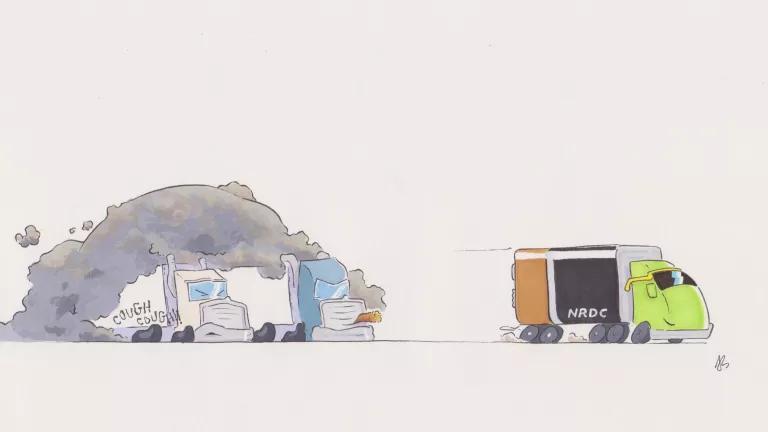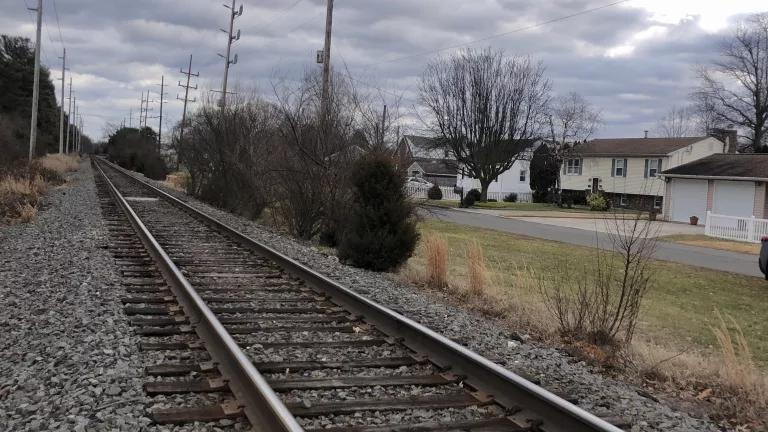New NRDC Analysis: Gov Shapiro's Energy Plan Is a Winner
Two foundational power sector policies, cap-and-invest plus ambitious clean electricity targets, provide significant benefits

Solar farm on abandoned mine lands in Beaver County, Pennsylvania
Commonwealth Media Services
After a much-anticipated rollout in mid-March, Governor Shapiro’s two-pronged legislative package to: (1) dramatically increase the percentage of Pennsylvania’s electricity sourced from clean energy; and (2) establish a PA-specific cap-and-invest program that would generate billions of dollars to reinvest in communities, has officially been introduced in the General Assembly. The Pennsylvania Climate Emissions Reduction Act, or “PACER,” is now House Bill 2275 and Senate Bill 1191, while the Pennsylvania Reliable Energy Sustainability Standards Act, or “PRESS,” is House Bill 2277 and Senate Bill 1190 (sponsors introduced identical companion bills in each chamber). All four bills have been referred to committee.
We’ve covered the extensive backstory of how we got here. Now, as we prepare for public hearings in Harrisburg and constructive dialogue with legislators to dig into the details, new modeling results commissioned by NRDC give insight into what the next decade might look like if the Commonwealth pursues/enacts both policies.
Consistent with preliminary estimates that have been highlighted by the Shapiro administration, our modeling concludes that adoption of PACER and PRESS would meaningfully drive down carbon emissions from PA’s fleet of fossil-fired power plants, protect and grow clean energy jobs, and result in overall utility bill savings for consumers. In short, this package squarely meets the governor’s three-part test on climate and energy policy.
We project these outcomes would occur all while Pennsylvania would also: see increased electricity generation and capacity; become an even more dominant electricity exporter; and experience an accelerated uptake of federal Inflation Reduction Act (IRA) clean energy tax credits.
What We Modeled
We have seen results like this before. They reflect clear, persistent trends in past Pennsylvania runs, as well as real-world experience in states that have adopted strong power sector policies. Here, NRDC analyzed a new policy scenario using the Integrated Planning Model (IPM). More details on the model can be found at the end of this blog.
The new scenario—where Governor Shapiro signs PRESS and PACER into law this year—was compared to a “business-as-usual” reference scenario (or “BAU”), in which Pennsylvania does not increase its clean energy targets. Our BAU scenario did include Pennsylvania implementing its CO2 Budget Trading Program, aka the RGGI Regulation (the Commonwealth’s RGGI participation has been threatened by politically motivated court challenges from fossil fuel-aligned interests for over two years and, while there is a pending appeal before the PA Supreme Court, we are confident the facts and the law are on RGGI’s side).
The BAU case also included all existing state and federal policies as of April 2023, e.g., the historic effects of the federal Inflation Reduction Act and Bipartisan Infrastructure Law. But it did not include the EPA’s recently finalized 111 carbon standards for new/modified gas plants and existing coal plants.
For purposes of this modeling (which was completed after the release of PRESS and PACER co-sponsor memos but before the release of final legislative text), we treated PACER largely as a proxy for RGGI except for one key caveat—PACER’s investments strategy. Consistent with the legislation, we assumed that at least 70% of the proceeds from the sale of PACER credits at PA-specific auctions would be returned to consumers in the form of electric bill rebates. Otherwise, PACER retains key aspects of the RGGI Regulation, which was finalized in April 2022.
Results and Analysis
- PRESS and PACER accelerate the build out of renewables in the state, resulting in greater near-term deployment of new renewables.
- PRESS and PACER result in significantly higher total PA generation and exports, especially into the 2030s. Net exports grow in the policy case to almost 120 terawatt hours (TWh) annually (whereas they decline under BAU). In the 2030s, Pennsylvania is exporting twice as much as the next largest exporter in the country.
- Between 2025 and 2042, the average PA household saves a total of $329 on electricity bills thanks to PRESS and PACER investments ($18 a year in 2022$). They would cut bills by 1.3% annually on average over the next two decades and by up to 2.4% annually in the mid-2030s.
- PRESS and PACER would result in a cumulative total increase of 278,000 new jobs (full-time equivalent job-years) in Pennsylvania by 2040. That represents an average annual increase of nearly 17,500 new jobs from 2025 to 2040.
- Pennsylvania is expected to see $25 billion in federal clean energy tax credits flow into the state over the next two decades, which will minimize costs to ratepayers and local companies. With PRESS and PACER, those investments are accelerated. Under BAU, $3.9 billion in credits will have flowed to PA by 2032 (after which there is less certainty about their availability). But under the policy scenario, that figure is $5.7 billion—nearly a 50% increase.
- As NRDC has highlighted before, a carbon pricing program is essential for decarbonizing the Commonwealth’s power fleet. Compared to past modeling of a scenario without either PACER or RGGI, PRESS and PACER would help lower in-state CO2 emissions by roughly 30 million tons annually during the 2030s. We also project lower emissions of CO2, NOx, and SO2 across the PJM footprint.

Significant PA CO2 emissions reductions | NRDC
This modeling confirms what we know about the impacts of tried-and-true power sector decarbonization policies like scaling up clean electricity targets and cutting pollution from dirty sources of energy through smart cap-and-invest programs.
To be clear, neither PRESS nor PACER looks exactly like legislation that NRDC would have drafted, but that shouldn’t come as any surprise. These bills are the byproducts of compromise and discussion amongst diverse stakeholders with competing interests and different perspectives.
PACER represents Governor Shapiro acting on the recommendations of his RGGI Working Group. And PRESS represents a new approach to expanding/updating Pennsylvania’s Alternative Energy Portfolio Standards (AEPS), which the governor committed to doing on the campaign trail. It would set a target of 35% retail electric sales from Tier I resources by 2035 (mostly renewables); it would also allow Tier I resources sited in Pennsylvania to compete for “reliable energy credits,” or RECs, alongside energy resources found in Tier II and Tier III, respectively.
Significantly, PRESS would deploy more renewables in the near-term and, as designed, it would keep Pennsylvania’s existing nuclear fleet (which currently provides 32% of PA’s total generation and over 90% of PA’s zero-emission generation) from prematurely retiring in the 2030s.
The overall picture is clear. The governor’s energy plan would cut climate pollution, lower bills, grow and protect jobs, and accelerate federal clean energy investments in-state. It delivers on the promise and potential we heard about when Governor Shapiro first announced his proposal. We expect a robust debate in Harrisburg in the months ahead but, once again, if Pennsylvania wants a brighter future, inaction is not an option.
A Note on the Integrated Planning Model: A Planning Tool for the Power Sector
In the power sector world, computer models are used to help forecast and understand the environmental and economic effects of different energy policies. The modeling in this blog represents assumptions developed by NRDC based on consultation with energy experts, partners, and industry. IPM is a detailed power sector model commonly used by the U.S. Environmental Protection Agency (EPA), utilities, and state regulators.


